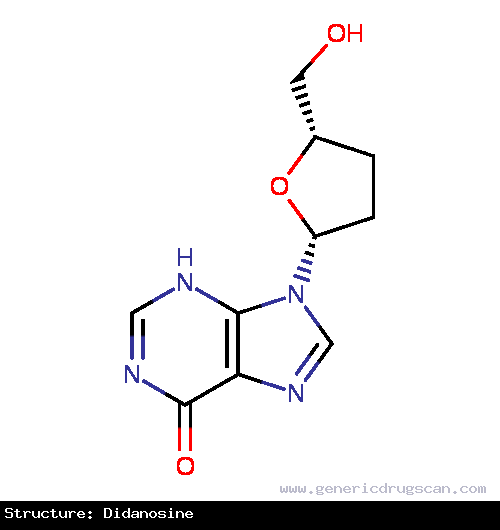Didanosine Drug: Indication, Dosage, Precaution, Side Effect , Storage, Category Type and corresponding Brands - www.genericdrugscan.com
Didanosine
Drug Status in USA : ApprovedDrug Status in Canada : Approved
pronunciation
pronounced as (dye dan' oh seen)
Why is this medication prescribed?
Didanosine is used along with other medications to treat human immunodeficiency virus (HIV) infection. Didanosine is in a class of medications called nucleoside reverse transcriptase inhibitors (NRTIs). It works by decreasing the amount of HIV in the blood. Although didanosine does not cure HIV, it may decrease your chance of developing acquired immunodeficiency syndrome (AIDS) and HIV-related illnesses such as serious infections or cancer. Taking these medications along with practicing safer sex and making other life-style changes may decrease the risk of transmitting (spreading) the HIV virus to other people.
How should this medicine be used?
Didanosine comes as extended-release (long-acting) capsules and a solution (liquid) to be taken by mouth on an empty stomach, 30 minutes before or 2 hours after eating. The extended-release capsules are usually taken once a day. The liquid is usually taken once or twice a day. Try to take didanosine around the same time(s) every day. Follow the directions on your prescription label carefully, and ask your doctor or pharmacist to explain any part you do not understand. Take didanosine exactly as directed. Do not take more or less of it, or take it more often than prescribed by your doctor.
If you are using the extended-release capsules, swallow them whole; do not split, chew, crush, break, or dissolve them. Tell your doctor if you are unable to swallow the extended-release capsules whole.
If you are using the solution, you should shake it well before each use to mix the medication evenly. Use a dose-measuring spoon or cup to measure the correct amount of liquid for each dose, not a regular household spoon.
Didanosine controls HIV infection but does not cure it. Continue to take didanosine even if you feel well. Do not stop taking didanosine without talking to your doctor. If you miss doses or stop taking didanosine, your condition may become more difficult to treat.
What are the precautions to be followed?
Before taking didanosine,- tell your doctor and pharmacist if you are allergic to didanosine, any other medications, or any of the ingredients in didanosine capsules or solution. Ask your pharmacist or check the Medication Guide for a list of the ingredients.
- tell your doctor if you are taking allopurinol (Aloprim, Lopurin, Zyloprim) or ribavirin (Rebetol, Virazole). Your doctor will probably tell you not to take didanosine if you are taking one or both of these medications.
- tell your doctor and pharmacist what other prescription and nonprescription medications, vitamins, nutritional supplements, and herbal products you are taking or plan to take. Be sure to mention any of the medications listed in the IMPORTANT WARNING section and the following: antacids: cimetidine (Tagamet), dapsone (Aczone), ganciclovir (Cytovene), hydroxyurea (Droxia, Hydrea), methadone (Dolophine, Methadose), ranitidine (Zantac), tenofovir (Viread), or valganciclovir (Valcyte). Your doctor may need to change the doses of your medications or monitor you carefully for side effects.
- you should know that some medications must be taken several hours before or after you take didanosine. If you are taking any of the following medications, ask your doctor exactly when you should take them: antifungals such as itraconazole (Sporanox), ketoconazole (Nizoral), and voriconazole (Vfend); atazanvir (Reyataz); delavirdine (Rescriptor); indinavir (Crixivan); nelfinavir (Viracept); quinolone antibiotics such as ciprofloxacin (Cipro), gatifloxacin (Tequin), moxifloxacin (Avelox), and ofloxacin (Floxin); ritonavir (Norvir); tetracycline antibiotics such as tetracycline (Sumycin) and tipranavir (Aptivus).
- tell your doctor if you have or have ever had peripheral neuropathy (numbness, tingling, burning, or pain sensation in your hands or feet, or decreased ability to feel temperature or touch in your hands or feet).
- tell your doctor if you are pregnant, plan to become pregnant, or are breast-feeding. If you become pregnant while taking didanosine, call your doctor. You should not breast-feed if you are infected with HIV or are taking didanosine.
- you should know that didanosine may cause side effects that must be treated right away before they become serious. Children who are taking didanosine may not be able to tell you about the side effects they are feeling. If you are giving didanosine to a child, ask the child's doctor how you can tell if the child is having these serious side effects.
- you should be aware that your body fat may increase or move to different areas of your body, such as your upper back, neck (''buffalo hump''), breasts, and around your stomach. You may notice a loss of body fat from your face, legs, and arms.
- you should know that while you are taking medications to treat HIV infection, your immune system may get stronger and begin to fight other infections that were already in your body. This may cause you to develop symptoms of those infections. If you have new or worsening symptoms after starting treatment with didanosine, be sure to tell your doctor.
What are possible side effects of this medication ?
Didanosine may cause side effects. Tell your doctor if any of these symptoms are severe or do not go away:- diarrhea
- headache
- muscle pain
- hives
- skin rash
- itching
- difficulty breathing or swallowing
- numbness, tingling, burning, or pain in hands or feet
- blurred vision
- difficulty in seeing colors clearly
Didanosine may cause other side effects. Call your doctor if you have any unusual problems while taking this medication.
How to store the medication and dispose it of after its use later?
Keep didanosine capsules in the container they came in, tightly closed, and out of reach of children. Store them at room temperature and away from excess heat and moisture (not in the bathroom). Keep didanosine liquid in the refrigerator, closed tightly, and throw away any unused medication after 30 days. Throw away any medication that is outdated or no longer needed. Talk to your pharmacist about the proper disposal of your medication.
Drug Category/Class
- Anti-HIV Agents
- Antimetabolites
- Reverse Transcriptase Inhibitors
- Nucleoside and Nucleotide Reverse Transcriptase Inhibitors
- Direct Acting Antivirals
- Antivirals for Systemic Use
- Antiinfectives for Systemic Use
- Nucleoside and nucleotide reverse transcriptase inhibitors
| Prescribed | For use, in combination with other antiretroviral agents, in the treatment of HIV-1 infection in adults. |
| Weight : | 236.2273 |
| Structure | Didanosine |
 | |
| Formula | C10H12N4O3 |
Didanosine has 10 Brands listed
| DDretro (250 mg) | DDretro (400 mg) |
| Dinex (100 mg) | Dinex EC (250 mg) |
| Dinex EC (400 mg) | Dinosin (100 mg) |
| Dinosin DR (250 mg) | Dinosin DR (400 mg) |
| Virosine DR (250 mg) | Virosine DR (400 mg) |
Search Generic Drugs alphabetically
